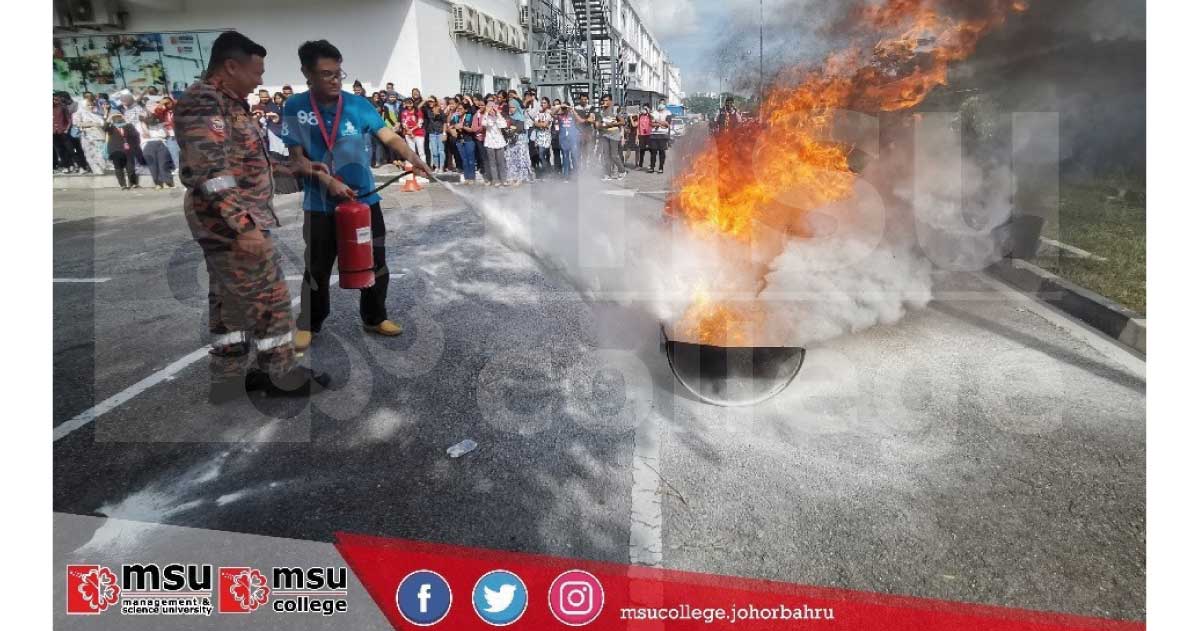

Fire-risk management is a fundamental responsibility, a primary requirement of occupational safety and health.
Fire safety training teaches one to recognize fire hazards, carry out a fire risk assessment, prevent a workplace fire, and respond to a fire emergency.
Last March, MSU College Johor Bahru invited the city’s Fire and Rescue Department to give a talk and demonstration on fire safety.

In a fire emergency, two acronyms remind building occupants of their duty for safety. One is R.A.C.E., which stands for Rescue, Alarm, Confine, Extinguish/Evacuate; and the other is P.A.S.S., standing for Pull, Aim, Squeeze, and Sweep the fire extinguisher.
When using a fire extinguisher, a low aim directed at the base of the fire is required.

A fire triangle, also called the combustion triangle, illustrates the three igniting elements of a fire – heat, an oxidizing agent (usually oxygen), and fuel. The fuelling agent is what classifies a fire.
Class-A fires are fuelled by solid combustible materials such as wood, paper, plastic, or clothing, and can be extinguished by a water or a foam fire extinguisher.
Class-B fires are fuelled by flammable liquids such as gasoline, alcohol, or oil (but not cooking oils or grease). A water fire extinguisher must not be used on a Class-B fire as the flaming material might be spread rather than extinguished by the water stream. Foam, powder, or carbon dioxide fire extinguishers are best suited to put out Class-B fires.
Class-C fires, which sometimes are classed as E in some countries, originate from electrical sources. Up until the power source is disconnected (when the fire then usually turns to a Class-A fire), Class-C fires need carbon dioxide or dry powder fire extinguishers. Water or foam must never be used on electrical fires as both can conduct electricity and increase the danger risk.

Class-D fires happen when a metal ignites. They rarely occur but when they do they typically occur in industrial settings; usually caused by alkali metals such potassium, magnesium, aluminum, and sodium igniting when exposed to air or water. Whilst dry powder extinguishers separate the fuel from the oxygen or remove the heat element from the blaze, water or foam extinguishers fuel the flame instead and can cause explosions.
Though they are sometimes categorized as Class B in some countries, fires involving cooking oils (both vegetable and animal fats) are normally classed as K or F. But just like Class-B fires, extinguishing them with liquids must not be attempted as it could create a dangerous splatter and spread the flame. Class K (/F) fires need a wet chemical extinguisher, which is mandatory in many commercial kitchens.
MSU Diploma in Occupational Safety and Health
MSU Bachelor in Occupational Safety and Health (Honours)
MSUrians lead best presentation in Japanese Safety Management Programme
What to do in the case of fire
MSU Emergency Evacuation Procedure
Fire-risk management is a fundamental responsibility, a primary requirement of occupational safety and health.
Fire safety training teaches one to recognize fire hazards, carry out a fire risk assessment, prevent a workplace fire, and respond to a fire emergency.
Last March, MSU College Johor Bahru invited the city’s Fire and Rescue Department to give a talk and demonstration on fire safety.

In a fire emergency, two acronyms remind building occupants of their duty for safety. One is R.A.C.E., which stands for Rescue, Alarm, Confine, Extinguish/Evacuate; and the other is P.A.S.S., standing for Pull, Aim, Squeeze, and Sweep the fire extinguisher.
When using a fire extinguisher, a low aim directed at the base of the fire is required.

A fire triangle, also called the combustion triangle, illustrates the three igniting elements of a fire – heat, an oxidizing agent (usually oxygen), and fuel. The fuelling agent is what classifies a fire.
Class-A fires are fuelled by solid combustible materials such as wood, paper, plastic, or clothing, and can be extinguished by a water or a foam fire extinguisher.
Class-B fires are fuelled by flammable liquids such as gasoline, alcohol, or oil (but not cooking oils or grease). A water fire extinguisher must not be used on a Class-B fire as the flaming material might be spread rather than extinguished by the water stream. Foam, powder, or carbon dioxide fire extinguishers are best suited to put out Class-B fires.
Class-C fires, which sometimes are classed as E in some countries, originate from electrical sources. Up until the power source is disconnected (when the fire then usually turns to a Class-A fire), Class-C fires need carbon dioxide or dry powder fire extinguishers. Water or foam must never be used on electrical fires as both can conduct electricity and increase the danger risk.

Class-D fires happen when a metal ignites. They rarely occur but when they do they typically occur in industrial settings; usually caused by alkali metals such potassium, magnesium, aluminum, and sodium igniting when exposed to air or water. Whilst dry powder extinguishers separate the fuel from the oxygen or remove the heat element from the blaze, water or foam extinguishers fuel the flame instead and can cause explosions.
Though they are sometimes categorized as Class B in some countries, fires involving cooking oils (both vegetable and animal fats) are normally classed as K or F. But just like Class-B fires, extinguishing them with liquids must not be attempted as it could create a dangerous splatter and spread the flame. Class K (/F) fires need a wet chemical extinguisher, which is mandatory in many commercial kitchens.
MSU Diploma in Occupational Safety and Health
MSU Bachelor in Occupational Safety and Health (Honours)
MSUrians lead best presentation in Japanese Safety Management Programme
What to do in the case of fire
MSU Emergency Evacuation Procedure